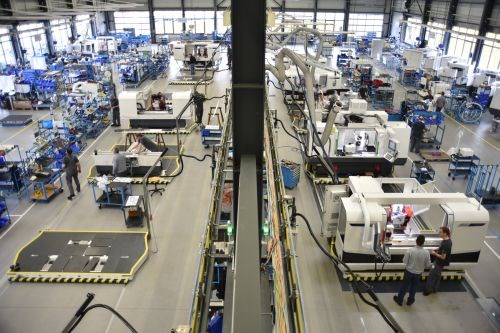New Super-Efficient Assembly Line Improves Productivity, Flexibility
Studer’s assembly line moves machines forward through 16 workstations without requiring them to be relocated for additional operations, including test grinding.

I recently had the opportunity to attend the 2016 Motion Meeting at United Grinding Group’s Studer facility in Thun, Switzerland (see the blog post and slideshow). As one of the first trade editors to witness the line in production—it was under construction for more than three years—I was impressed by the flow and efficiency of the process. Here is a list of some details Studer representatives shared with me.
According to the company, the Flow-Assembly+ process incorporates all manufacturing operations for the entire Studer product portfolio into one assembly line, enhancing the company’s ability to quickly meet specific customer demands and delivery requirements. The process divides assembly for Studer internal and external cylindrical grinding machine into 16 stations, which are arranged in a U shape. On the first side of the U, a normal rail system is used. On the second side—where the laser measurement and test grinding of the machine in motion take place—there is a high-precision conveyor system that is approximately 130 feet in length, which corresponds to a large, high-precision machine tool guide.
The 16 stations are divided into four segments, in which as many as four employees per station assemble the complex machines. The line is designed for a single-shift system, with two four-hour sessions and runs continuously for four hours at a speed of 1.375 miles per hour. The line is currently set up to produce two machines a day, with the flexibility to increase output as demand grows.
With the Flow-Assembly+ process, machines are ready for delivery to customers once they have passed the last station in the line. Design modifications such as special, in-process gaging systems or customer-specific clamping systems, as well as laser measurement and test grinding, are integrated into the flow. To further enhance productivity, the required assembly parts are delivered to the line just in time and directly from the warehouse, partly via Kanban. Every four hours, material is delivered for the next four hours, including the provision of all necessary parts and tools.
Prior to implementation of Flow-Assembly+ in October of last year, Studer used fixed-station and non-continuous paced assembly for production. Implementation of the new process is a result of the company’s PuLs continuous development and improvement program.
I found the entire project to be proof of the company’s commitment to continuous improvement and the desire to serve its markets and customers well.

Assembly parts are delivered to the line just in time and directly from the warehouse, partly via Kanban. Every four hours, material is delivered for the next four hours.
RELATED CONTENT
-
Simplifying Machine Load/Unload Automation
Today, lower part volumes and frequent change-over are changing the offerings of some automation integrators. Standard, off-the-shelf components are being engineered to work together in a large variety of applications and, in some cases, are even portable so they can be moved from machine tool to machine tool.
-
10 Smart Steps to Take Toward Recovery
With many manufacturers facing challenges in light of the novel coronavirus pandemic, these 10 steps can help position manufacturers to find success.
-
The Effects of Automation on Manufacturing
Companies that are not currently using automation in their manufacturing processes should be considering it.


